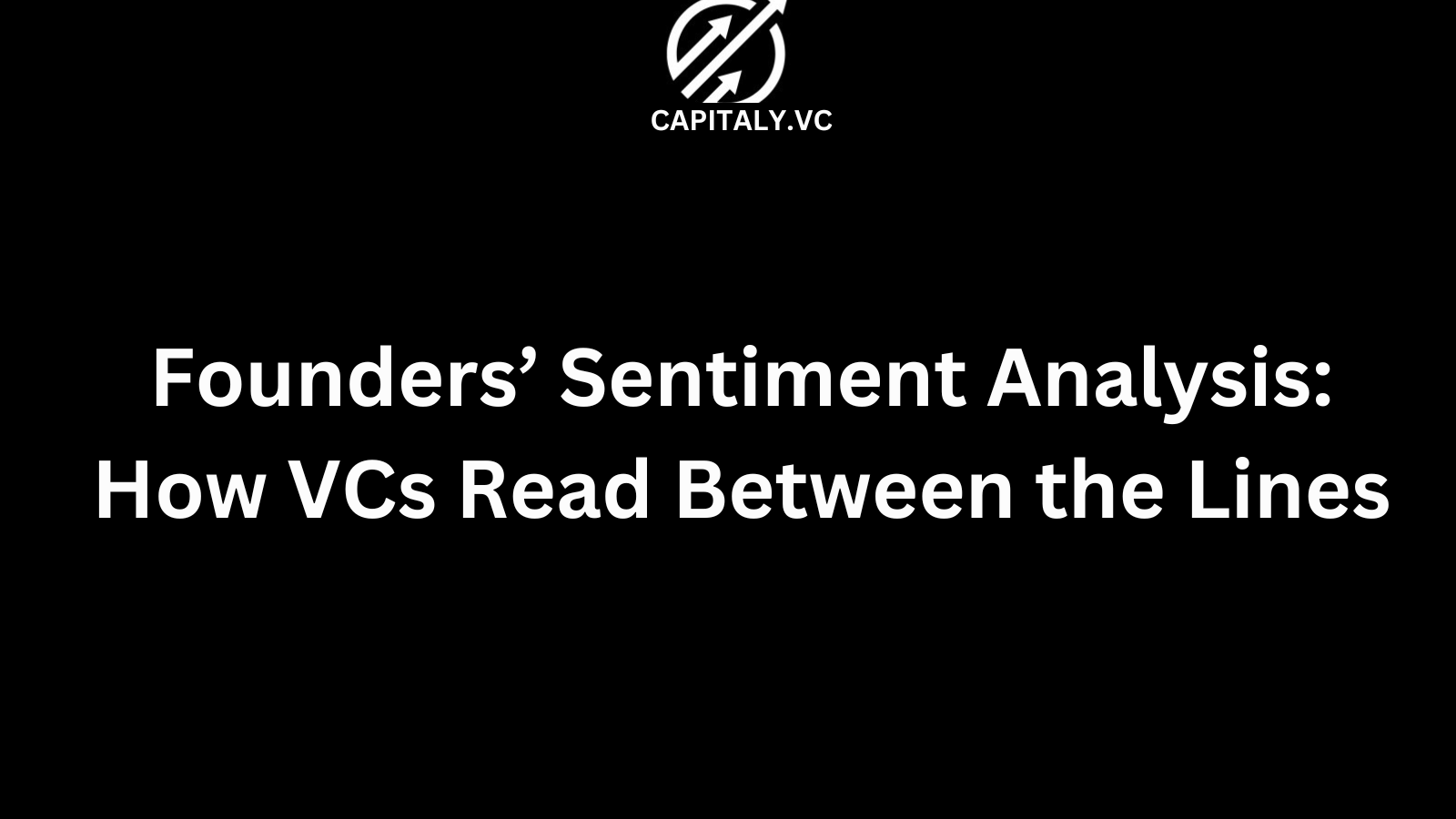Founders’ Sentiment Analysis: How VCs Read Between the Lines
Founders’ Sentiment Analysis: How VCs Read Between the Lines

Why do some founders get funded in 10 minutes—while others, with better metrics, struggle for months?
It often comes down to something that doesn’t show up on a spreadsheet: founder sentiment.

In 2025, VCs aren't just analyzing numbers—they’re analyzing people.
This post breaks down how investors use founders’ sentiment analysis to make faster, more confident decisions.
You'll learn how your tone, story, and subtle emotional cues influence the odds of closing your next round.
What Is Founder Sentiment Analysis?
Founder sentiment analysis is the study of a founder's emotional signals, confidence, and consistency during fundraising interactions.
It's not just about what you say—but how you say it.
VCs are looking for:
- Confidence under pressure
- Emotional consistency
- Signals of long-term commitment
Some rely on gut instinct.
Others use AI-driven platforms that track everything from eye movement to tone modulation.
Psychological Traits VCs Look For in 2025
In 2025, these traits dominate the VC checklist:
- Grit: Have you powered through hardship?
- Coachability: Can you learn and adapt fast?
- Clarity of thought: Can you simplify the complex?
- Optimism grounded in realism: Do you believe in your vision without delusion?
If you're missing these, sentiment analysis will catch it—before the pitch ends.
AI vs. Human Judgment: Strengths and Gaps
Humans are intuitive.
AI is consistent.
Here’s how they compare:
AttributeAI ToolsHuman InvestorsSpeedReal-time analysisSlower, experientialBiasData-driven, but still biasedHeavily biasedPattern recognitionExcellent with dataStrong with soft signalsEmpathy/ContextWeakStrong
Smart VCs combine both.
Top AI-Based Tools for Sentiment Analytics
Here are the platforms VCs are quietly using:
- Humantic AI: Predicts personality fit
- Sybill: Analyzes tone, energy, and emotional intelligence
- Trout AI: Scores founder responses during interviews
- Gong.io: Originally built for sales, now repurposed for VC calls
These tools pick up micro-signals no human can track live.
Case Studies: Wins and Misses in Founder Assessment
🔍 The Win: A founder in Lagos with no warm intro scored a $4M seed after AI revealed rare levels of resilience and clarity during a cold pitch.
💣 The Miss: A B2B SaaS founder showed promising metrics but fumbled the pitch. AI flagged burnout. The round fell apart.
Takeaway?
VCs aren’t just listening to your deck—they’re decoding your energy.
Red Flags Every Investor Watches For
- Inconsistent answers: If your vision and numbers don’t match, you’re out.
- Overconfidence: Sounds like BS. Investors prefer thoughtful ambition.
- Low energy or hesitation: Indicates burnout or lack of belief.
These aren’t small mistakes.
They're deal killers.
How to Present as a Resilient, Investable Founder
Want to pass the vibe check?
Here’s how:
- Practice your pitch under stress. Investors are judging composure.
- Know your numbers cold. No waffling.
- Share setbacks and comebacks. VCs love bounce-back energy.
For more on high-stakes pitching, see our blog post: [Internal Link: The 5-Minute Fundraising Framework].
Emotional Intelligence in Pitch Meetings
EQ > IQ in meetings.
Here’s why:
- Founders with high EQ adapt mid-call.
- They read the room, even on Zoom.
- They handle objections without defensiveness.
Train this like a muscle.
Storytelling That Signals Growth Potential
Every investor wants to believe in your trajectory.
The best way to convince them?
Tell a story that includes:
- A clear “before and after”
- A defining turning point
- A vision that’s inevitable, not optional
For more on narrative development, see: [Internal Link: How to Craft a Founder Story That Raises Capital].
Detecting Burnout and Commitment Levels
Yes, VCs can sense burnout.
Even through a screen.
Signs they watch for:
- Low affect (flat tone, no sparkle)
- Vagueness on vision
- Defensive body language
Fix it before the pitch.
Sleep. Rehearse. Reconnect with your “why.”
Patterns in Successful vs. Failed Pitches
Here’s what the best founders do:
- Speak in frameworks, not rambles
- Pause for effect—don’t rush
- Show passion and practicality
The worst?
They talk too much, dodge questions, and drown in buzzwords.
Training VCs: Bias in Sentiment Analysis
AI doesn’t remove bias. It encodes it.
Smart firms train their analysts to:
- Recognize cultural differences in expression
- Avoid over-indexing on "Western" confidence cues
- Value substance over presentation
This is still a work in progress.
Future of LLMs in Founder Due Diligence
LLMs like GPT-5 and Claude 3 Opus are now used to:
- Summarize founder interactions
- Score interview quality
- Benchmark pitch language vs. unicorn founders
This is the new background check.
Sentiment Analytics and Diversity in Founding Teams
Here’s the catch:
Sentiment tools sometimes penalize non-native speakers or neurodiverse founders.
VCs using these tools must:
- Calibrate for global voices
- Rely on diverse deal teams
- Validate with human intuition
For more, see our blog post: [Internal Link: Diversity and Inclusion in VC: Why It Matters Now].
Building Trust as a Founder: Tips for 2025
You don’t need to be perfect.
You need to be:
- Consistent
- Self-aware
- Forward-looking
Trust is built when your answers match your eyes.
FAQs
What is founder sentiment analysis in VC?
It’s the evaluation of emotional cues and psychological traits in founders to predict fundability.
How do VCs analyze sentiment?
They use both AI tools and human observation during calls, meetings, and pitches.
Are AI tools replacing VC intuition?
No. They’re enhancing it—especially for pattern recognition and bias reduction.
What tools do investors use for founder analysis?
Common ones include Sybill, Humantic AI, Trout, and Gong.
Can emotional signals affect funding outcomes?
Absolutely. A founder’s tone and energy can be deal-makers or breakers.
How can founders improve their sentiment scores?
Practice under pressure, get feedback, and use video analysis tools.
What are red flags in a pitch?
Inconsistency, overconfidence, low energy, and unclear vision.
Do these tools disadvantage diverse founders?
Sometimes, yes. That's why firms are adapting their models for fairness.
How do I show resilience in a pitch?
Share a specific failure—and exactly how you overcame it.
Is sentiment analysis here to stay?
Yes. It’s already embedded in most elite firms’ due diligence processes.
Conclusion
In 2025, VCs don’t just invest in traction or TAM—they invest in founders who radiate conviction.
Founders’ sentiment analysis is now a core part of the fundraising game.
And it’s here to stay.
Want to raise faster and smarter?
Subscribe to Capitaly.vc to raise capital at the speed of AI.


.png)